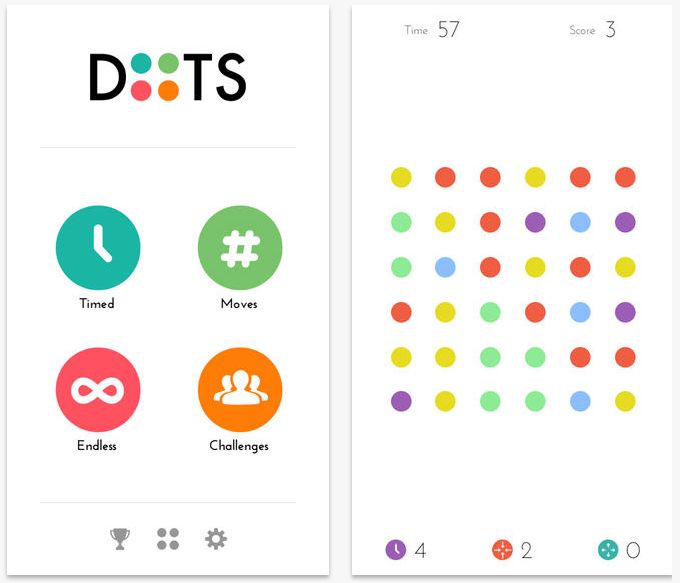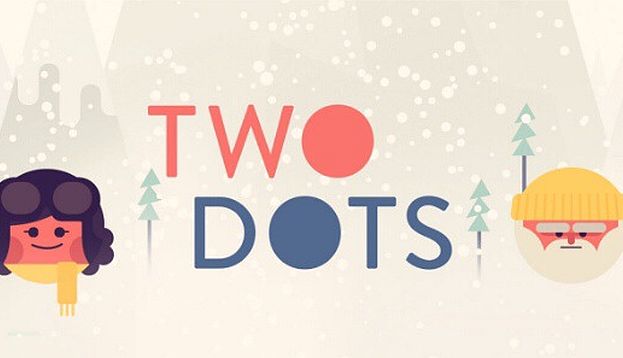There’s nothing more difficult for an unknown mobile game developer than attracting enough of an audience to make a living. Thus, when you hear about a studio that’s done that twice, it’s worth paying attention. Dots is the name of the studio that created both Dots and Two Dots, both very successful mobile games. The studio is an outgrowth of Betworks, a startup studio and seed stage venture capital company in New York City that’s created other successful companies like Chartbeat and Bitly.
Dots was released in April of 2013 for iOS and quickly shot up the charts, being downloaded more than one million times in its first week. In two weeks, the game had been downloaded more than two million times, and users had played over 100 million games. The game was later released on Android in August of last year.
Dots was followed up this year by Two Dots, billed as the sequel to Dots. It’s using the same central gameplay of Dots but in a fashion that’s more akin to how Candy Crush Saga progresses, with new puzzles to solve using the basic mechanic of forming squares.
The simple, elegant gameplay has won multiple awards as well as a large audience of players. What lessons have been learned along the way about marketing mobile games The [a]listdaily checked in with Dots’ head of marketing Christian Calderon to get some insights into how developers can meet the marketing challenge.
 Christian Calderon
Christian Calderon
What role, if any, has marketing played in the success of Dots?
I joined the team in May, specifically to launch Two Dots. Dots initially had tremendous success prior to my joining the company. The overall picture of how marketing played a role in the success of Two Dots was a combination of the product, the brand marketing we put out, and also the performance marketing side and how we tried to combine both brand and performance marketing.
What’s your marketing strategy for Two Dots, and how was that informed by what you learned from Dots?
When we first launched Dots, it was one of those things when people saw it they wanted to touch it and they wanted to play with it. The core game mechanic was very strong, and the brand we were building resonated with users. With Two Dots we wanted to build on that. We emphasized more on brand. We came out publicly and said that we’re trying to build a brand, we’re trying to be a game studio with a strong brand. Essentially the brand we were building resonated with our users. What we found through social media channels was that we saw every month our engagement rates would go up with the volume of followers we had, as people were engaging with the content we were pushing out. With Dots we knew something was there but we just didn’t know how far we could push that, how far we could rely on that and how our users would react. We took a chance and it worked.
It sounds like connecting with your audience through social media was a very important part of your strategy.
Absolutely. The data we that get from our users on social media is extremely helpful. It allows to know what our users are interested in, the music, what countries they come from, what their demographic is, and then we can take that data and then amplify it and find users that are very similar to them in other markets around the world. Because of that we were quickly able to launch Two Dots in over 70 countries. We were able to extract similar users who were interested in Two Dots globally. Social media has definitely had a big part in that.
Which social media channels were most important to you, and why?
The two most important ones — and I would say they are equally important — are Facebook and Twitter. Twitter actually never used to really be there for us, and it recently has emerged as a network that has been very strong, both on the performance marketing side and on the brand marketing side. We’re able to optimize for engagement on Twitter, and we can’t do that on Facebook. But then Facebook is complementary, because we can still optimize engagement on Facebook, just not to the extent that we can on Twitter. On Twitter you see these viral trends happen so quick, people talking about things. You see things trending in different parts of the world,and it’s a social construct that’s really hard to replicate. With Facebook it’s great because it gives us a lot of user insight data. Twitter also gives us some data, but it’s not as powerful as the insights we get from users on Facebook. They’re both a little different, but we use them both and they complement each other.

Do you think your marketing strategies are transferable to other games and other developers?
The exact strategy that we use is not transferable to other titles or genres. I would say the foundation, the framework we use is transferable. For example, the way we calculate LTV, the basic construct and equations we use in performance marketing, that’s very transferable to other games. The problems that we’re trying to solve of attracting users and and how to retain them, that’s very transferable. But the strategy and approach we take to do that is a little bit different, because as a casual games marketer we have various advantages and disadvantages.
What’s your best advice for mobile game marketers What should they try to do, and what should they avoid doing?
The problem of attracting users to your game is not always the responsibility of the product itself. If the product is original, beautiful, and fun, that in itself should help acquire and retain users. In terms of marketing the product itself, and figuring out how to do that, you have to learn how to navigate the ecosystem. The best thing you can do is just talk to some of the industry experts in mobile marketing and get everyone’s advice. Everyone’s going to give you different advice, and you have to take in all this feedback and figure out exactly what you think will work best for your game.
The other problem is there’s a monetary barrier to entry. On the performance marketing side it costs money, and getting over that barrier for startups is going to be hard because many times the budget’s not there. Learning how to mitigate costs is extremely important, especially in a macro environment where more ad dollars are shifting to mobile, more entrants are coming to market, and CPIs are going up. Understanding how to mitigate that cost is extremely important. That can be done by trying to employ virality, that can be done by trying to optimize for engagement — those are the two most powerful ways to do that.
The early users that come into your game are going to be the most loyal, the most valuable from an LTV perspective, they’re going to be the most engaged. Optimizing your SEO tactics are very important, and anyone can do that. Figuring out which key words are important, optimizing your app store description, those are the most helpful things for a startup when they’re first coming in and trying to market their product.

